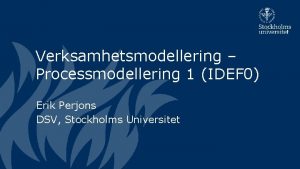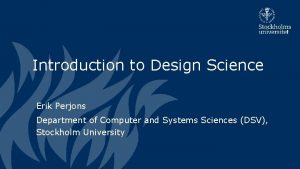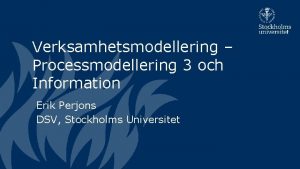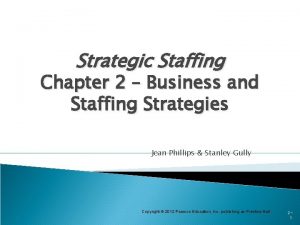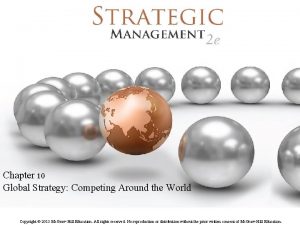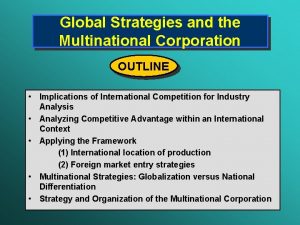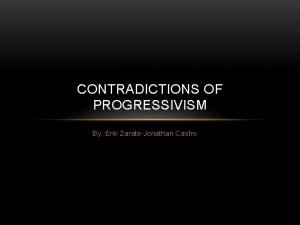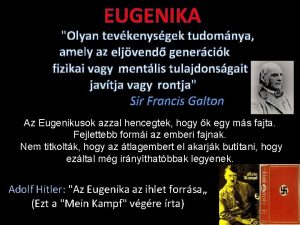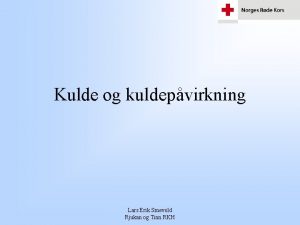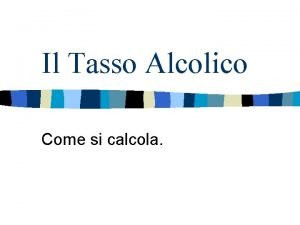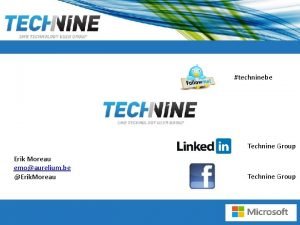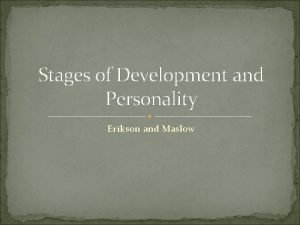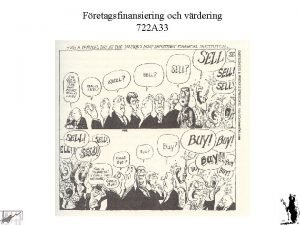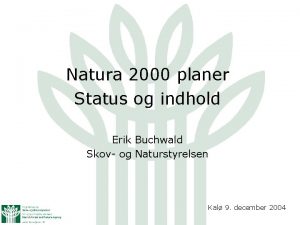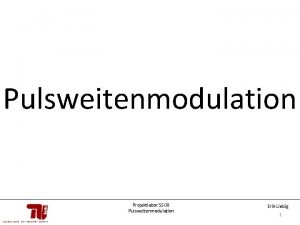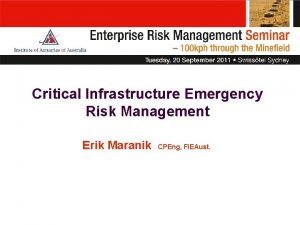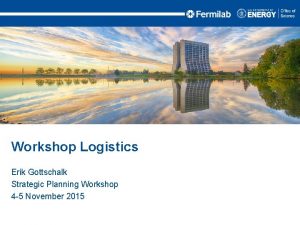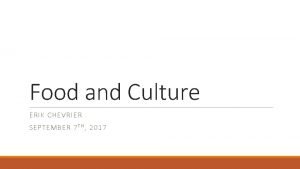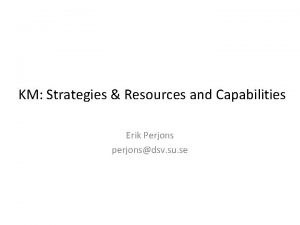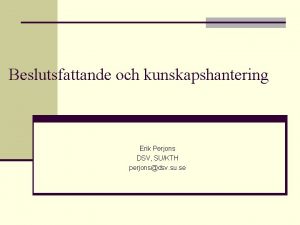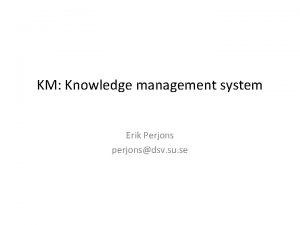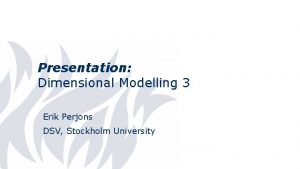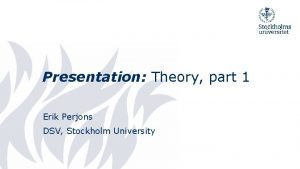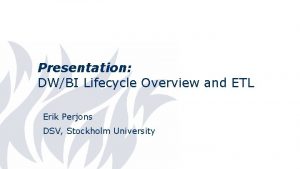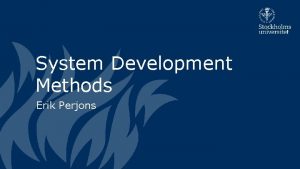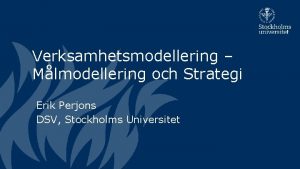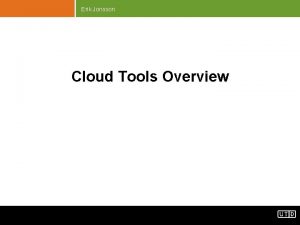KM Strategies Erik Perjons perjonsdsv su se Strategy










































- Slides: 42

KM: Strategies Erik Perjons perjons@dsv. su. se

Strategy

Strategy • Strategy is a coherent patterns of actions to acheive the goals of the organisation. An important part of a strategy is to allocate the resources effectively • Strategies can be found on different organisational levels Corporate (group) level Business area level (Line of business) Corporate strategy Division level Business unit level Function Business strategy or Competitive strategy

Strategy planning process • Kotler and Keller (2006) presents a rational top-down view on strategy developmnent/planning, that is a step-by-step development of strategy (see figure below) • Note, however, that many researchers claims that strategy development is more irrational, more implicit (e. g. using just a budget to govern), that is, a strategy is often not formulated, instead it is emerged from bottom-up, that is, emerged from actual operational actions carried out in the organisation (see Mintzberg) External analysis Business mission Goal formulation Research main interst for many years Strategy formulation Program formulation Increased research interst lately Implementation Feedback and control Internal analysis (Kotler & Keller, 2006)

Strategic tool used by Kotler: SWOT for internal and external analysis STRENGTH • The personnel work fast • … Internal • The pizza oven is slow • … Favourable Unfavourable THREAT OPPORTUNITY • The prices for products are low • … WEAKNESS • There are many other pizzerias in the city • … External

Different strategic perspectives • Porter school • Resource and competence based strategies - Resource based view of the firm • Customer value and process based strategies • Digital strategies • Innovation school • . . . The following slides are partly based on Bengtsson&Skärvad (2011) Företagsstrategiska perspectiv, Akademilitteratur

Strategic tool: Porter’s five forces analysis Michael Porter’s five forces model shows five forces (or factors) in an industry that impact the profabilty of the industry in general and for an organisation specifically in that industry. It can be used as a tool for an organisation for: • analysing how attractive it is for an organisation to invest and do business in an industry • developing strategies for managing the forces in order to achieve long-term competive advantages A competive advantage is an advantage that a firm has over its competitors, allowing it to generate greater sales or margins and/or retain more customers than its competitors. There can be many types of competitive advantages including the firm's cost structure, product offerings, distribution network and customer support (Investopedia) Threat of new entrants Bargaining power of suppliers Intensity of competitive rivalry Bargaining power of customers Threat of substitute products or services According to Porter: If all the forces are strong, most of the organisations in the industry have low profability. If all the forces are weak most of the organisations in the industry have high profability

Strategic tool: Porter’s five forces analysis The threat is high if it is easy for other companies to enter the market (usually because it only requires small investments) Threat of new entrants How can this threat be weakend ? Bargaining power of suppliers The bargaining power of suppliers is high if they for example have many customers to sell to How can this power be weakend ? The bargaining power of customers is high if they for example have many suppliers to buy from. Intensity of competitive rivalry The intensity is high if many organisations are competing with the same products for the same customers How can this intensity be weakend? How can this power be weakend ? Bargaining power of customers Threat of substitute products or services The threat is high if the company’s products or services can be replaced by other products or services How can this threat be weakend ?

Strategic tool: Porter’s five forces analysis • • Long-term profability for an organisation can be achieved by developing strong competive advantages According to Porter there exists two generic competitive advantage: – Cost advantages – the organisation has lower costs, for example because of economy of scale, efficient processes, etc, compared to its competitors – Diffentiation advantages – the organisation has unique products or unique marketing process etc, which makes the customer willing to pay more for the products than for competitors’ producs If a organisation has succeded to develop a compettive advantage it means that the organisation succeded to manage the five forces better than the competitors The knowledge of five forces can be used to develop the strategies of the organisation, that is, the use of generic strategies (Bengtsson&Skärvad, 2011)

Strategic tool: Porter’s generic strategies Michael Porter’s generic strategies present the major strategic choice an organisation can do for achieving long term profability Competitive advantage Lower cost Competitive scope Broad target Narrow target Cost leadership Cost focus Differentiation focus

Strategic tool: Porter’s generic strategies Low prices Focused on part of the market or a certain customer group The whole market Competitive advantage Lower cost Competitive scope Compete with a low price for a certain part of the market (e. g. by using efficient processes and few product variations) Distinguish itself from competitors Broad target Narrow target Compete with a low price for the whole market (e. g. efficient processes and few product variations) Differentiation Cost leadership Differentiation Cost focus Differentiation focus Distinguish itself from competitors by high product quality or customisation for a certain part of the market Distinguish itself from competitors by high product quality or customisation for the whole market

Resource and competence based strategies • The relation between the external world, strategy, and the internal resources and capabilties have always been an important theme in strategic thinking • During the 1980 s, the focus was on strategy and the external world, mainly in form of industry analysis, such as Porter’s • During the 1990 s, the interest changed, and the focus was on strategy and the internal resources and competences. • These ideas are sometimes called the resource base theory of the firm (Bengtsson&Skärvad, 2011)

Resource and competence based strategies • • • The major ideas are that resources and competences are a stable base for an organisation’s strategy in an ever changing world. The company should identify its internal strenghts and manage these in a structured way. The unique resources and competenes are the major sources for competitive advantages. Such resources and competences could be the brand, production and distribution resources, customer relations, and technology Moreover, if the organisation focus too much on the customers’ need (a customer driven strategy) there is always a risk that the organisation needs to adapt too much to the customer, and end up in areas where the organisation has problem competing with other organisation. Therefore, a more long term strategy is to focus on its resources and competences and develop and make use of these. Example of organisations using a competence based strategies are ABB and IKEA. Example of organisations using a more customer driven approach are SAS and Sears (Bengtsson&Skärvad, 2011)

Resource and competence based strategies • • Important in a competence based strategy is to develop so called core competences A core competence is an integrated combination of technologies, knowledge and resources, which through organisational learning has developed to excellence. This means that a core competence can seldom be found in individuals and groups in the organisation. Therefore, organisational learning and competence development are important in an organisation A brand or a production process is not a core competence – it is rather the capability to organise, govern and manage the brand or a production process and utilise these to create customer value and competitive advantages Core competences are hard to imitate for other organisations, such as an innovative organisational culture The core competences are the base that provide the business units and products with a stable flow of knowledge, resources and contacts leading to new products and new markets However, a new technology can make some core competence worthless. Therefore, the organisation need to develop core competences all the time and be ahead the competitors (Bengtsson&Skärvad, 2011)

Resource and competence based strategies • How to develop competences? • Prahalad and Hamel (1990) claims that a strategic architecture need to be developed showing which core competences (the base) exist and how they are related, and how they can be used to create new products lines and products as well as create new markets for using the core competences • An real life example. Canon has used its core competences in optics, mechanics and electronics not only to develop cameras, but also to develop copy machines, calculators and other office machines (Bengtsson&Skärvad, 2011)

Resources, Capabilities, Competences and Core Competences • Authors, like Mansour Javidan, has include the concept of capabilities in the hierarchy of resources, competences and core competences. • The following slides are partly based on Javidan (1998) ”Core Competences – What doas it mean in practice? ”. He has based his thinking on Prahalad and Hamel (1990) Core Competences Capabilities Resources

Resources • A resource is an object that is viewed as being valuable by some actor. A resource is typically scarce; otherwise an actor would not consider it as valuable. For example, ice would not count as a resource at the North Pole where it is abundant, neither would sand in Sahara. • Some concrete examples of resources are books, money, cars, movies, hair cuts, and medical treatments. • Organisations has a bundle of resources, but not every organisation can put its resources into best use. That is, organisations vary in how they leverage their resources • Reources are at the bottom of the hierarchy in previous slide

Catergorising resources • Resources can be categorised in many ways, for example: – physical resources such as plant, equipment, location and assets – human resources such as manpower, management team, training and experience; and – organisational resources such as culture and reputation • Resources can also be categorised in this way: – transferable resource is a resource that can be transferred between two actors. These are often only valuable as an instruments for producing other resources. Examples of transferable resources are cars, blueprints, money (which is a medium for exchange) and services such as hair cut – non-transferable resource is a resource that cannot be transferred between to actors, such as beauty, health state, honour, and glory. They are often desired by people for their own sake, but could also be used as instruments for other purposes (e. g. beauty could be used for producing money)

Catergorising resources • Resources can be categorised in this way as well: – tangible and physical such as plant and equipment – intangible like a brand name • Resources can also be categorised in this way: – goods, which are physical objects, like cars, refrigerators, and cell phones – services, which are resources that encapsulate other resources and are used to increase the value of some other resource. A hair cut can increase the beauty and an eye treatment can give better health state – information, which is data in a certain context, like blueprints, referrals, and customer databases – money, which is a medium for exchange. – vouchers, which is a certificate that can be exchanged for another specific economic resource, e. g. a good or a service. Usually, a voucher can be exchanged only with some pre-specified actor(s). Money can be viewed as the most general form of voucher without any restriction on economic resources and actors.

Conversion vs transfer of resources There are two main ways of increasing value of resources in an organisation: conversion or transfer of resources (Hruby, 2011) Conversion process input resource resource Exchange process output resource Conversion process output resource Exchange process input resource Organisation B Exchange process Organisation A input resource output resource Conversion process input resource

Conversion vs transfer of resources There are two main ways of increasing value of resources in an organisation: conversion or transfer of resources money to procurement Conversion process money from cutsomers money from customers money cockies money Exchange process cockies bread Exchange process flour Conversion process bread Exchange process suger Organisation B Exchange process Organisation A bread cockies Conversion process cafe packages Conversion process money from customers money to procurment

Conversion vs transfer of resources Enterprise models can be used for representing conversion and transfer of resources process input resource Exchange process Business process models Conversion resource Value network models resource Exchange process output resource Conversion process output resource Exchange process input resource Organisation B Exchange process Organisation A input resource output resource Conversion process input resource

Capabilities • • • Capabilities often refer to the corporation’s ability to exploit its resources. They are the second level in the hierarchy and consist of a series of business processes and routines that manage the interaction among its resources. A process is a set of activities that transform an input into an output. For example, a company’s marketing capability can be based, among other things, on the interaction among its employees (marketing specialists), technology (computer hardware and software), business processes, and financial resources. A capability is usually interpreted as resident in a particular function. For example, there are marketing capabilities, production capabilities, distribution and logistics capabilities and human resource management capabilities. [Mansour. J. : "Core competence: what does it mean in practice? . " Long range planning 31. 1 (1998): 60 -71]

Competency • • A competency, the third level in the hierarchy, is a cross-functional integration and co-ordination of capabilities. In a multi-business corporation, competencies are a set of skills and know-how housed in an business unit. They result from interfaces and integration within a business unit’s functional capabilities For example, a particular business unit may possess the competency of developing successful new products. Such a competency may be the consequence of integrating MIS capabilities, marketing capabilities, R&D capabilities and production capabilities in the business unit [Mansour. J. : "Core competence: what does it mean in practice? . " Long range planning 31. 1 (1998): 60 -71]

Core Competencies • • • Core competencies are skills and areas of knowledge that are shared across business units. They are the result of interaction, integration and harmonization of business unit competencies. They are the highest level in the hierarchy, and cross business unit boundaries. Core competencies require collective organizational learning, involvements and a commitment to cross-business-unit integration. Core competences are hard to imitate, provide high customer value, give access to new mark [Mansour. J. : "Core competence: what does it mean in practice? . " Long range planning 31. 1 (1998): 60 -71]

Features of the hierarchy Core Competences Value Capabilities Resources Difficulty

Features of the hierarchy • • Each level in the hierarchy is based on the level below. It results from the integration of the elements in the lower level. Each level encompasses a higher level of value added for the company. Resources on their own add little value. Functional capabilities generate value by deploying resources. Competencies add greater value because they expand the boundaries of capabilities. They result from synergies among capabilities. Core competencies add the greatest value since they exploit resources and capabilities at the broadest level, across the organisation as a whole [Mansour. J. : "Core competence: what does it mean in practice? . " Long range planning 31. 1 (1998): 60 -71]

Bank example • A bank may have good information system (IS) capability in the sense that it generates high quality information about its customers. It may also possess the skills to develop new financial products to serve the customers better, but it will realise maximum value if it has competence to get its IS and marketing skill sets to work together to better leverage its assets. The bank may have several offices located in different cities. Each geographic location may have developed, over time, a series of specific skills. To the extent that the bank can leverage this knowledge across its network of offices, it can realize greater value, for example learn how to sell new services to the most profitable customers. This means make use of its core competences [Mansour. J. : "Core competence: what does it mean in practice? . " Long range planning 31. 1 (1998): 60 -71]

Other definition of capability • Services and capabilities are two trendy concepts in the information system area. Why? • There exist many different definitions: – Capability is the ability to continuously deliver a certain business value in dynamically changing circumstances [Stirna et al, 2013) – Capability is a business functionality that, through a service, delivers a welldefined user need [OASIS, SOA reference architecture, 2011] – Capability is the ability to achieve a desired effect under specified [performance] standards and conditions through combinations of ways and means [activities and resources] to perform a set of activities [Unified Profile for Do. DAF and MODAF (UPDM), 2012]

Customer value and process based strategies • In the middle of 1990 s, the concepts of customer value and business processes became important among business executives and managers • The customer value based strategies were focussed on increasing the customer value by develop competitive customer offers (sometimes called value propositions). The strategy aims to deliver offers that is valued by customers, and therefore, offers that they are willing to pay for • Accoriding to Kotler (1999) there are three ways to deliver more customer value than the competitors: – Lower prices (H&M, IKEA) – Lower other costs for the customer, such as provide secure operations and maintenance, fast complain service, high quality post market service (for buying follow-on products) – Provide add on values (cusomisations, fast service, professional service, accessability, flexibility)

Customer value and process based strategies • The customer value based strategies require that the organisation decide which value to deliver, that is, decide the value proposition. • Kaplan and Norton (1996) has presented a generic model for value proposition: Value Functionality = Product features Quality + Price Image + Time Relations

Customer value and process based strategies • Closly related to the customer value based strategies are process based strategies. • In process based strategies, such as BPR, customer value claims to be created in the processes. Therefore process analysis, process design and focus on the creation of customer value are in focus • Products are developed, produced, sold and delivered in business processes. • Employees that work in well-designed processes can make use of their knowledge and skills • In process based strategies, the focus shifts somewhat from strategy development to strategy implementation, although it is important to identify the core processes and activities, that is, the ones that really makes a difference for the organsations

Digital strategies • The basic idea in digital strategies is to exploit digital technology for new business models to enhance customer value and competitiveness • Especially, the digital business network becomes central in digital strategies • ICT makes the interaction between actors in the network less costly: Internet is used for transactions and communications between actors in the network (Bengtsson&Skärvad, 2011, Tapscott & Lowy, 2000)

Digital strategies – Business Models • A business model describes the rationale of how an organization create and deliver value for its customer and other stakeholders. • A business model is usually described by presenting resources exchanged between suppliers and the organization as well between the organization and its customer (so called transfer or exchange processes). • Moreover, a business model often also presents how input resources are transferred to output resources within an organization (so called conversion processes) (Bengtsson&Skärvad, 2011, Tapscott & Lowy, 2000)

Digital strategies • As mentioned, the digital business network becomes central in digital strategies • Tapscott & Lowy (2000) describe different digital strategies – based on the relationships between the organisations in the network – mainly way of governing the network and way of integrating value between involved partners in the network • The customer's role usually becomes more active in digital strategies - as a: – producer of data in social media (Web 2. 0), – active designers and evaluators, and – user of self-service (like during online check-in), etc. (Bengtsson&Skärvad, 2011, Tapscott & Lowy, 2000)

Real time strategies • Real Time Strategies are strategies developed in a world that is becoming more complex and ever changing • Researchers claim that in situations of high uncertainty, it is hard to get acceptance for one common strategy. Instead several competing strategies often emerge. This, however, does not need to be negative, at least according to those advocating real time strategies (Bengtsson&Skärvad, 2011, Weick, 1998)

Real time strategies • Real time strategies emphasize the acting in real time and learn from the actions instead of planning. This can be promoted by: – – creating confidence among employees to manage unusual situations creating a good understanding of internal resources and capabilities having a set of methods and models to apply when unusual situation emerge stimulating greater risk taking among employees • Real time strategies often accept several strategies in parallel. This can be promoted by creating and supporting multiple self-organized team and multiple cultures • Real time strategies often accept slack in the organization to support learning and innovation (Bengtsson&Skärvad, 2011, Weick, 1998)

Innovation strategies • Today, companies need to be innovative, that is create new goods and services - as well as develop new ways of organizing, producing, distributing and marketing • Not that an innovation does not have to be a new good or service, it can also be a new production method, a new market, a new organization, or a refined and enhanced existing good or service • Innovation is beneficial for both organisations and societies. Innovation use resources in a more valuable way - and create economic growth for organisations and societies – think of the container that really change the way of transporting goods on sea and land • In general it is claimed that an idea, invention, good and service is not enough to be called an innovation, it also need to be accepted by the market (note the difference between invention and innovation) (Bengtsson&Skärvad, 2011)

Innovation strategies - Christensen • Clayton Christensen at Harvard Business School claims that established companies mostly enhance and refine existing goods, services and processes. They usually do not create new disruptive technologies • Christensen also claims that new companies that try to enter a market by enhancing and refining existing products, mostly fail (only 6 percent was successful) • Moreover, Christensen claims that new companies that introduced totally new technologies were more successful (33 percent according to Christensen’s investigations). The reason for this, according to Christensen, is that the new technology often has low quality (in the beginning) and a small market, and, therefore, in general, established companies do not care about the new technology (Bengtsson&Skärvad, 2011, Christensen, The Innovator’s Dilemma, 1997)

Innovation strategies - Christensen • Christensen means that established companies seem to overrate the value of established technology, goods, services, markets and processes, and underestimate new, disruptive, technologies • New technologies is instead mainly created by new companies entering a market • Clayton Christensen means that established companies can be more aware of the opportunities with new technologies by asking two questions: – Does the new technology makes it possible for new customer groups with less buying power to access and make value of the new goods and services based on the new technology? – Does the goods and services based on the new technology attract less attractive market segments that does not need all the functionalities that existing products and services have? • By asking this questions, established companies can better understand manage threat of new technologies (Bengtsson&Skärvad, 2011, Christensen, The Innovator’s Dilemma, 1997)

Innovation strategies - Chesbrough • Chesbrough means that many established companies believe that new ideas are mainly created within the companies (“all the smart people work for us”), while many new ideas, goods and services can be introduced by customers or by researchers at universities • Chesbrough means that today the research and development cost are increasing and the life cycles of goods and services are faster and shorter. Therefore, new models need be used to lower cost of the innovation process • Open innovation models is a possible solution – make use of smart people both within and outside the company, and ideas from inside and outside can also be combined in order to develop new business models. The companies need to open their innovation processes, according to Chesbrough (Bengtsson&Skärvad, 2011, Chesbrough, Open Business Models: How to Thrive in New Innovation Landscape, 2006)

Innovation strategies - Chesbrough • Chesbrough also state that between 75 and 95 percent of all patents are never used • Therefore, many patents and innovations can be licensed or sold, instead of not being used at all • Chesbrough also means creative customers should be engaged more actively (like provide open source code to the public and involve lead users in design). This is also the case with researchers. University projects and researchers can be sponsored in order to co-create ideas and inventions (Bengtsson&Skärvad, 2011, Chesbrough, Open Business Models: How to Thrive in New Innovation Landscape, 2006)
 Processhanteringssystem
Processhanteringssystem Erik perjons
Erik perjons Erik perjons
Erik perjons Erik perjons
Erik perjons Flödesenhet synonym
Flödesenhet synonym Porters värdekedja
Porters värdekedja 9 elements of staffing strategy
9 elements of staffing strategy Globalization strategy
Globalization strategy Corporate strategy vs business strategy
Corporate strategy vs business strategy Aligning hr strategy with business strategy
Aligning hr strategy with business strategy Concentric growth strategy
Concentric growth strategy Multi domestic strategy
Multi domestic strategy Global strategy
Global strategy Multinational strategy vs global strategy
Multinational strategy vs global strategy The strategy
The strategy Crafting and executing strategy in strategic management
Crafting and executing strategy in strategic management Multidomestic marketing strategy
Multidomestic marketing strategy Bottom-up listening strategies examples
Bottom-up listening strategies examples Progressivism def
Progressivism def Dr pianka
Dr pianka Erik jonsson school of engineering and computer science
Erik jonsson school of engineering and computer science Erik gottschalk
Erik gottschalk Erik tillmann
Erik tillmann Lars erik smevold
Lars erik smevold Calcolo tasso alcolemico formula
Calcolo tasso alcolemico formula Polling applets
Polling applets Erik werlauff død
Erik werlauff død Technine group
Technine group Maslow's hierarchy of needs vs erikson's stages
Maslow's hierarchy of needs vs erikson's stages Erik golrang
Erik golrang Erik groessl
Erik groessl Erik demaine
Erik demaine Erik adli
Erik adli Erik buchwald
Erik buchwald Pulsweitenmodulation
Pulsweitenmodulation Erik coleman
Erik coleman Scoala gimnaziala nr 1 ludus
Scoala gimnaziala nr 1 ludus Erik maranik
Erik maranik Erik gottschalk
Erik gottschalk Hvorfor 5 innblåsninger ved drukning
Hvorfor 5 innblåsninger ved drukning Per alnefelt
Per alnefelt Erik chevrier
Erik chevrier Erik joling
Erik joling

